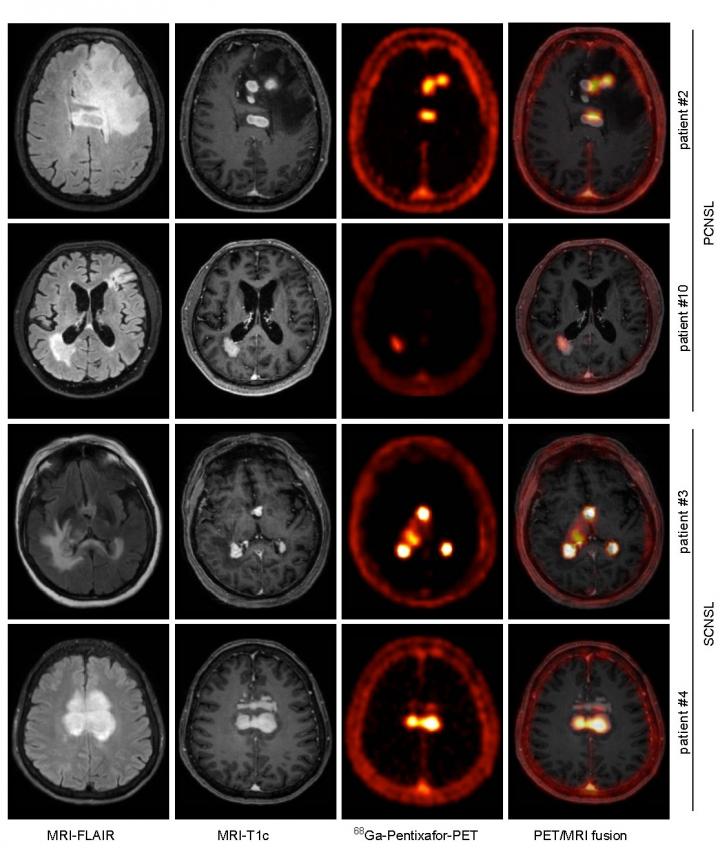
Credit: Images created by Department of Nuclear Medicine, School of Medicine, Technische Universität München, Munich, Germany.
Reston, Virginia–Positron emission tomography (PET) imaging with 68Ga-pentixafor is an effective diagnostic tool for central nervous system (CNS) B-cell lymphoma, according to a proof-of-concept study published in the December issue of The Journal of Nuclear Medicine. Targeting the CXCR4 biomarker involved in the growth, survival and dissemination of aggressive B-cell lymphoma, 68Ga-pentixafor PET imaging shows excellent contrast characteristics between lymphoma lesions and surrounding healthy brain tissue and may be suitable for risk stratification and response assessment.
“CNS B-cell lymphoma is a rare malignancy that has several clinical challenges, including diagnosis, risk stratification and optimization of treatment,” said Ulrich Keller, MD, PhD, head of the department of hematology, oncology, and tumor immunology at Universtitätsmedizin Berlin (Campus Benjamin Franklin), in Berlin, Germany. “Magnetic resonance imaging (MRI) is the current standard imaging technology for this disease, and while it provides high sensitivity, it offers only moderate specificity. Novel molecular and functional imaging strategies are urgently required for this patient population.”
In a retrospective analysis to investigate this issue, 11 patients were imaged with 68Ga-pentixafor PET (four with PET/computed tomography and seven with PET/MRI). Lesions were analyzed, and immunohistochemistry was conducted. In the seven patients for whom post-treatment MRI scans were available, response to treatment was compared between the pre-treatment MRI and CXCR4-directed PET scans.
CXCR4-directed PET imaging with 68Ga-pentixafor was found to be positive in all active CNS lymphoma lesions, with a high tumor-to-background ratio that offered exceptional contrast. CXCR4 expression in vivo was validated by positive immunohistochemistry for CXCR4; in nine out of 11 patients for whom lymphoma biopsies were available, CXCR4 was highly expressed in the lymphoma lesions. Additionally, CXCR4-directed PET uptake values were found to have a significant prognostic value, indicating that lymphoma lesions with lower CXCR4 tracer uptake values were associated with a better response to standard treatment.
“This is significant for CNS B-cell lymphoma patients, as CXCR4-directed PET imaging with 68Ga-pentixafor could not only facilitate diagnostic work-up and response assessment but could also serve as a biomarker for selecting patients with a dismal prognosis who could benefit from more intense treatment options,” noted Peter Herhaus, MD, hemato-oncologist in the department for internal medicine III at the School of Medicine at Technische Universität München in Munich, Germany. “CXCR4-targeted theranostics thus moves nuclear medicine further on the track toward biomarker-informed molecular medicine.”
###
This study was made available online in April 2020 ahead of final publication in print in December 2020.
The authors of “CXCR4-Targeted Positron Emission Tomography Imaging of Central Nervous System B-Cell Lymphoma,” include Peter Herhaus and Florian Bassermann, Internal Medicine III, School of Medicine, Technische Universität München, Munich, Germany; Jana Lipkova, Benedikt Wiestler and Wolfgang Weber, Department of Neuroradiology, School of Medicine, Technische Universität München, Munich, Germany; Felicitas Lammer and Stefan Habringer, Department of Hematology, Oncology, and Tumor Immunology (Campus Benjamin Franklin), Charité-Universitätsmedizin Berlin, Berlin, Germany; Igor Yakushev, Tibor Vag and Markus Schwaiger, Department of Nuclear Medicine, School of Medicine, Technische Universität München, Munich, Germany; Julia Slotta-Huspenina, Institute of Pathology, Technische Universität München, Munich, Germany; Constantin Lapa, Department of Nuclear Medicine, Universitätsklinikum Würzburg, Würzburg, Germany, and Department of Nuclear Medicine, University Hospital Augsburg, Augsburg, Germany; Andreas K. Buck, Department of Nuclear Medicine, Universitätsklinikum Würzburg, Würzburg, Germany; Tobias Pukrop, Internal Medicine III, Universitätsklinikum Regensburg, Regensburg, Germany; Dirk Hellwig, Department of Nuclear Medicine, Universitätsklinikum Regensburg, Regensburg, Germany; Martina Deckert, Institute of Neuropathology, University of Cologne, Faculty of Medicine and University Hospital Cologne, Cologne, Germany; Hans-Jürgen Wester, Institute of Pharmaceutical Radiochemistry, Technische Universität München, Munich, Germany; Björn Menze, Informatics Department, Technische Universität München, Munich, Germany; and Ulrich Keller, Internal Medicine III, School of Medicine, Technische Universität München, Munich, Germany, Department of Hematology, Oncology, and Tumor Immunology (Campus Benjamin Franklin), Charité – Universitätsmedizin Berlin, Berlin, Germany; Max-Delbrück-Center for Molecular Medicine, Berlin, Germany, and German Cancer Research Center (DKFZ) and German Cancer Consortium (DKTK), Heidelberg, Germany.
Disclosures: Ulrich Keller and Andreas Buck serve on the advisory board of PentixaPharm, the company developing licensing of pentixafor and pentixather. Hans-Juergen Wester is co-inventor of pentixafor and pentixather and shareholder of Scintomics, which is a shareholder of PentixaPharm. This work received funding from Deutsche Forschungsgemeinschaft SFB 824 (Markus Schwaiger, Hans-Juergen Wester, and Ulrich Keller) and SFB 1335 (Ulrich Keller), from Stiftung Charit´e (Ulrich Keller), and from the German Cancer Consortium (Markus Schwaiger, Hans-Juergen Wester, and Ulrich Keller). No other potential conflict of interest relevant to this article was reported.
Please visit the SNMMI Media Center for more information about molecular imaging and precision imaging. To schedule an interview with the researchers, please contact Rebecca Maxey at (703) 652-6772 or [email protected].
About the Society of Nuclear Medicine and Molecular Imaging
The Journal of Nuclear Medicine (JNM) is the world’s leading nuclear medicine, molecular imaging and theranostics journal, accessed close to 10 million times each year by practitioners around the globe, providing them with the information they need to advance this rapidly expanding field. Current and past issues of The Journal of Nuclear Medicine can be found online at http://jnm.
JNM is published by the Society of Nuclear Medicine and Molecular Imaging (SNMMI), an international scientific and medical organization dedicated to advancing nuclear medicine and molecular imaging–precision medicine that allows diagnosis and treatment to be tailored to individual patients in order to achieve the best possible outcomes. For more information, visit http://www.
Media Contact
Rebecca Maxey
[email protected]
Original Source
http://www.
Related Journal Article
http://dx.



